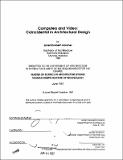Computers and video : coincidental in architectural design
Author(s)
Gardner, Janet Elizabeth
DownloadFull printable version (4.776Mb)
Other Contributors
Massachusetts Institute of Technology. Dept. of Architecture.
Advisor
James Anderson.
Terms of use
Metadata
Show full item recordAbstract
This thesis proposes a new tool for the designer that acts as an Intelligent adjunct In the design process. Architects express abstract concepts in physical concrete realities. The tools of the trade act as a medium through which to express these concepts; pencil. paper. models. Yet these tools do not allow for any intelligent discourse. While translating an abstract Idea into a physical object. a designer must keep track of complex associations between various elements within a design. As an idea becomes further developed. the associations between elements become more difficult to manage. On occasion matrices are employed to maintain a consistent relational system. yet complexity often forces design concepts to get distorted or lost. This thesis provides one solution; a method for to the management of this barrage of associative information. while still providing a stimulating design environment. With the proposed tool. a designer can use numerous media simultaneously; for our purposes digital video and an object-oriented graphics editor. The video environment acts as an analysis tool for exploring existing archetypes. In search of inherent themes. The graphics editor is a tool for synthesizing objects. creating a whole from a series of parts discovered in the video environment. The key to this tool is its ability to retain knowledge while acting as an intelligent adjunct in the design process. The designer operates with objects. These objects "know" what their behavior Is. and how to perform certain operations. Other attributes and relationships can also be attached to objects. or classes of objects. Compilation of both environments Is possible. due to a central knowledge base that maintains all the information from all objects. This single knowledge base allows objects In one environment to be shared by the other. creating an interactive environment between two Independent media. computers and video. and eliminating the bold line that separates the two.
Description
Thesis (M.S.)--Massachusetts Institute of Technology, Dept. of Architecture, 1987. Includes bibliographical references (leaves 92-94).
Date issued
1987Department
Massachusetts Institute of Technology. Department of ArchitecturePublisher
Massachusetts Institute of Technology
Keywords
Architecture.